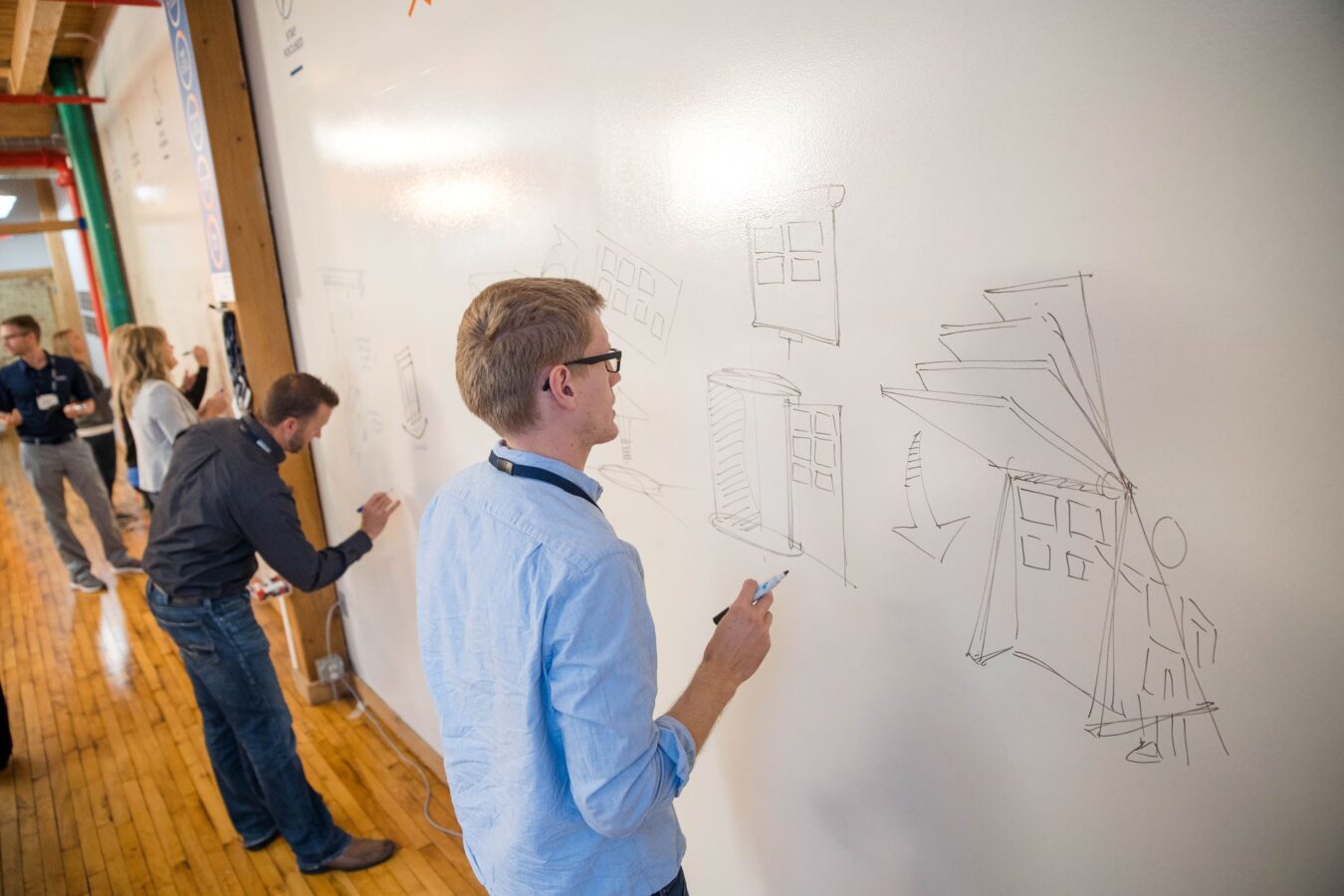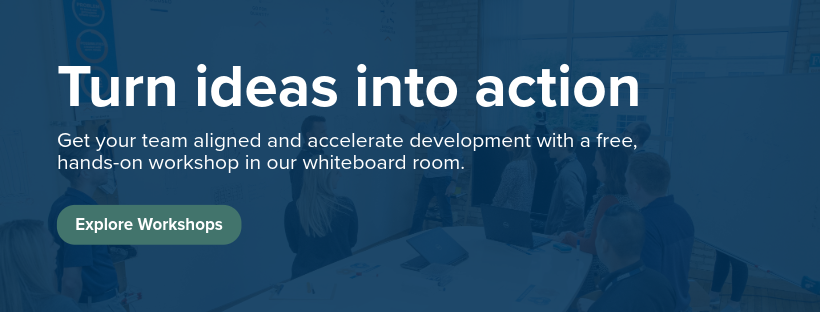The 6 Key Components of an Effective Product Brainstorming Session
Nov 21, 2025 | 2 min read

You know the feeling. Your team gathers for a “brainstorming” session, but half the room is quiet, ideas repeat themselves, and the energy fades fast. You leave wondering if anything meaningful came from it.
Brainstorming should be exciting, collaborative, and productive, but too often, it’s not. At DISHER Engineering, my team has helped hundreds of organizations—from startups to Fortune 500s—unlock new ideas and get aligned around the right ones. We’ve seen what works (and what kills creativity). This post will break down what makes a brainstorming session truly effective so you can do the same in your organization.
Here’s what I’ll cover:
- What a product brainstorming session is (and why it matters)
- When and how to hold one
- Who should be in the room
- How to structure and facilitate it
- What to do after it’s done
- When to bring in outside help
What Is a Product Brainstorming Session, and Why Does It Matter?
A product brainstorming session is a focused, collaborative meeting where team members generate and refine ideas for new products, features, or solutions.
But it’s not just “throwing ideas on a whiteboard.” These sessions are about spending quality time developing “divergent” ideas to ensure that when the team “converges” on a select few concepts, no stone was left unturned.
In engineering and product development, a good brainstorming session brings together people from different disciplines—designers, engineers, marketers, and even manufacturing leads—to solve complex problems faster and more creatively.
It matters because early collaboration reduces blind spots and helps the team align before major design or cost decisions are made. In our experience, skipping this step can lead to rework, misalignment, or missed opportunities later in development.

When Should You Hold a Brainstorming Session?
The best time is when you’ve defined a problem clearly but haven’t locked in on a path forward. It’s not an exact science, but if you’re too early, your ideas may lack direction. Too late, and people may already be attached to solutions.
Some good moments are:
- After research or discovery, when insights are fresh
- When you’ve hit a design roadblock and need new angles
- Before major concept development or prototyping
Who Should Be in the Room for an Effective Brainstorming Session?
A great session depends on who’s there and how safe they feel contributing.
Typically, you should have a mix of:
- Core team members (engineers, designers, project leads) who know the constraints
- Cross-functional voices (manufacturing, marketing, service) who add real-world perspectives. Unless you’re dealing with confidentiality limitations, you want to avoid limiting participation to only technical experts because outside perspectives are typically less biased, better represent the voice of the customer, and are often the ones that lead to unexpected, but brilliant, breakthroughs.
- A facilitator—someone who guides the flow and keeps the conversation balanced and involved
Regardless of team or title, psychological safety in the brainstorming room is important. Everyone should feel free to share ideas without fear of judgement or being shot down.
How Do You Prepare for a Product Brainstorming Session?
Many brainstorming sessions fail because teams “just wing it.” Here’s how to set the stage:
- Clarify your goal. Are you solving a design challenge? Generating new concepts? Improving an existing feature?
- Define the problem clearly. A strong “How might we…” statement keeps discussion focused. This definition significantly drives the direction of ideas produced. Too focused, and you get similar solutions across contributors, too large, and you’re likely to produce ideas beyond the desired scope.
- Bring the right data. Include research, user feedback, surveys, etc. Sketches and prototypes make for great visual aids but be careful to indicate what is and what is not required in these concepts to avoid “putting ideas into a box.”
- Set an agenda. Block time for warm-up, ideation, discussion, and next steps.
- Choose your tools. Whether in person or virtual, have whiteboards, sticky notes, or Miro ready.
A well-prepared session creates freedom. It’s not structure for its own sake, but boundaries that focus creativity where it matters. For example, these are the boosters and boundaries we use during our brainstorming sessions:

The 6 Key Components of an Effective Brainstorming Session
Here’s how to structure your session for success.
1. Start with the Problem
Revisit the challenge or opportunity to make sure everyone is aligned. Keep it visible throughout the session.
2. Warm Up the Room
Simple creative exercises or quick “bad idea” rounds lower the pressure and open people up.
3. Generate Ideas
Use methods like:
- SCAMPER (Substitute, Combine, Adapt, Modify, Put to another Use, Eliminate, Reverse)
- Rapid ideation: Time sprints with as many ideas as possible
- Silent brainstorming: Everyone writes ideas individually before group sharing
4. Discuss and Build
Encourage “yes, and” thinking. Combine ideas or evolve them together. It’s important for the facilitator to guide this portion well to ensure voices are heard and don’t devolve into judgements which stifle others from openly sharing.
5. Evaluate and Prioritize
Cluster similar ideas and identify the most promising based on feasibility, impact, and alignment with goals. It’s vital that this convergent process happens as a group as well.
6. Capture Everything
Document every idea, even the wild ones. You can do this by taking notes, or sometimes pictures are better because your brainstorming might include drawings or visuals.
How Do You Keep a Brainstorming Session Productive and Avoid Groupthink?
Groupthink is the silent killer of innovation. When people feel pressured to agree, great ideas never surface.
Here’s how to keep energy and creativity high:
- Rotate voices: Don’t let the loudest dominate. Invite quieter team members to share.
- Use timeboxing: Keep each phase short and focused.
- Encourage quantity over quality (for the divergent phase of ideating).
- Hold feedback until later: Evaluation too soon can kill momentum.
- Appoint a facilitator: This person should be neutral—not the boss or decision-maker.
Bringing in an external facilitator can be a good idea in some scenarios. They’re unbiased, trained to draw out every voice, and help your team see ideas from new angles.
What Happens After a Brainstorm? Turning Ideas into Real Product Concepts
A brainstorm isn’t over when the meeting ends! Without follow-up, even the best ideas can disappear into notebooks.
Here’s what should happen next:
- Organize the ideas. Group similar ones and identify themes.
- Evaluate feasibility. Which ideas are realistic given your time, cost, and resources?
- Select top concepts. Decide which to prototype or explore further.
- Assign ownership. Someone should always own the “next step.”
Use a simple matrix to score ideas on impact vs. effort. It’s a quick way to spot the most valuable opportunities.
When Should You Bring in a Third-party Facilitator?
Even the most capable and creative teams can benefit from an outside perspective. You might consider external facilitation when:
- Internal dynamics limit creativity or honest discussion
- You’re tackling a high-stakes or strategic product challenge
- You want to build team alignment across departments
A third-party facilitator can push thinking further, ask hard questions, and make sure all ideas get heard.
Our team at DISHER Engineering often partners with teams at this stage, acting as both a catalyst and a neutral guide. We help clients discover new directions they might not have seen from the inside.
Get an inside look at our brainstorming process >>
Get Better Ideas from Your Next Brainstorming Session
You now know what makes a product brainstorming session truly effective, from preparation to facilitation and all the way through follow-up.
If your team’s sessions feel stale or repetitive, it might be time for a reset. My team at DISHER Engineering would love to lead your next ideation session and hopefully drive better collaboration and results. You can contact us online here to get one scheduled.
Written By:

Andrew Hemphill
Concept Engineer
DISHER Newsletter
Sign up to receive articles and insights, delivered monthly.
Schedule a no-committment project call
Reach out to discuss your project to find out if DISHER could be a good fit for you.
